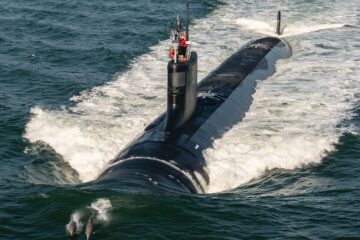Sponsored content

To understand that complexity, just imagine a surface vessel and a submarine side by side and look at the antennas embarked on both of them. The surface vessel gets its radiocommunication antennas dispatched from stem to stern and from deck to the top of the mast. The idea is to separate HF, VHF, UHF, IFF … antennas from each other to prevent any interference between them. Submarine gets one single antenna mast where all the very same frequencies must closely work together!
Another difference between surface vessels and submarines, as far as the HF radiocommunication antennas are concerned, is the way to remove heat from the HF antenna tuning unit during HF transmission. Natural air wind is enough for surface vessels, which is not possible for submarines where the HF antenna tuning unit is part of the antenna mast, enclosed in a tight envelope making a barrier against heat exchanges with outside! The challenge here is to find a way to remove heat despite the critical lack of space and lack of heat-exchanger surface.
Last but not least, the envelope itself, made up of reinforced fiber-glass has to match with two contradictory requirements. The first one is to be thick enough in order to withstand huge efforts due to the waves when the submarine is at periscopic dive while the second one is to limit the same thickness in order not to impact HF performances. A delicate balance at a high technical stake!
Now, assuming that all the above technical challenges have been met, there is another natural barrier that puts strong limitations to the way a submarine can communicate by radio at sea: we have named the sea surface. No radiocommunication wave, except Very Low Frequency (VLF), can penetrate into the water. This means the submarine is out of radio communication once its communication mast antenna is under the water. Different solutions allow solving that critical question, at least partially.

The first one is to go back to the surface for the radiocommunication mast antenna to be outside the water and able to communicate. But the cost in terms of susceptibility is pretty high!
The second option is to tow a Buoyant Wire Antenna which is a floating cable of several hundred meters long, a part of it being at the sea surface and able to receive VLF and HF frequencies. An online-amplifier shall be embedded in the cable to compensate the important transmission losses in the cable between its receiving part and the submarine itself. The online-amplifier is at technical stake also: how to integrate electronic boards in around 16mm diameter that will resist to the depth pressure and particularly to the mechanical efforts generated by the wet or dry winch during “filage” and “ravalage” of the BWA? Sure that cost in terms of susceptibility is less than first option but this system offers limited or poor radiocommunication capabilities (VLH, HF reception only).

A third option is now possible to allow a submarine to communicate at depth and speed at no susceptibility cost but advanced radiocommunication capabilities, thanks to the innovative X-SUB expendable communication buoys.
X-SUB buoys are launched from a submarine at speed and depth by a standard signal ejector of 3 or 4’’ of. Once ejected, the X-SUB buoy floats up to the surface while remaining connected to the submarine by a fibre-optic link. At sea surface, the X-SUB buoy starts communicating as a remote antenna. The communication is possible as long as the fibre-optic link is not fully unreeled. Then, the fibre-optic link breaks and the X-SUB buoy automatically scuttles.

This opens two new capabilities: RF wideband transmission and reception on the one hand and Iridium communication on the other hand. Wideband X-SUB buoys allow reception of the full spectrum covering VLF, HF, VHF, UHF, IFF and GPS and allow also VHF and UHF transmission. This is a game changer for tactical data exchange between submarine at depth and surface or aerial means.
Iridium satcom X-SUBs allow to send a phone call from submarine or to communicate by chat messages with shore for example. Encryption software can be implemented by the end-user to enhance communication security.
Communication is a critical key factor nowadays. Submarines have always been limited in their capacity to communicate at depth and speed. Today, wideband X-SUB buoys overcome that limitation, offering new capacity to transmit and receive tactical data while submarines remain deeply under the cover of the sea.





